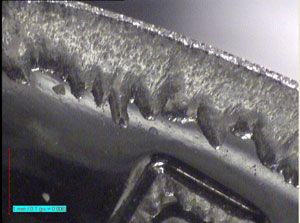Choosing Tableting Tooling for Compressing Abrasive Formulations
Wear-resistant materials and coatings protect tablet punches and dies from abrasive formulations.
Formulating solid-dose products that can be compressed in a modern tablet press at high speed presents technical challenges. The trend toward use of natural ingredients, particularly in nutraceutical formulations, makes this challenge more difficult because natural ingredients tend to be unrefined, hard, abrasive, and sometimes corrosive. These characteristics can cause excessive wear of the compression faces of the punches and dies (see Figure 1). Tablet punches and dies, which are the main components that interface with the powders and granules, must be robust both metallurgically and in regard to tablet/punch tip design to withstand the rigors of compaction.
Figure 1. A typical example of punch tip wear caused by abrasive formulations. Image is courtesy of I Holland.

With punches, the first option to overcome abrasive formulations is to use a more wear-resistant premium steel. It is important to fully understand the differences between the variety of steels available and the advantages and disadvantages of selecting different steels. For example, a wear-resistant steel may be less resistant to fracture in some applications due to reduced toughness and tensile strength. If the changeover to a premium steel does not offer the extra wear resistance required, then a powder metallurgy steel will provide greater wear resistance.
Dies should always be made from steel that has superior wear resistance to a standard punch steel. Commonly used materials for tooling generally are based around high-carbon, high-chrome cold-work tool steels. But when extended wear resistance is required, tungsten carbide is often used for the dies. It combines a high compressive strength with an extremely high wear resistance, which helps to reduce die bore wear, deformation, and ringing and lasts longer than conventional die steels. This material is commonly used within the pharmaceutical market, but it can sometimes react with certain ingredients and leave black marks on the tablet outside diameters. If this problem occurs, a powder metallurgy steel, which does not react with these ingredients, can be used.
If the selection of a more wear-resistant steel is not sufficient, then a wear-resistant coating can be applied to the tooling. I Holland’s PharmaCote RS, for example, is a wear-resistant coating that is approximately five times harder than normal tablet-tooling steels. This extreme increase in hardness is possible due to the very thin nature of the coating combined with its elemental composition. If the steel could be made this hard, it would be brittle and would almost certainly fracture in use. The brittleness of a hard coating, however, can be offset by the structure of the coating itself and toughness of the substrate if the coating–steel combination is selected correctly. More advanced wear-resistant coatings continue to be developed by I Holland Ltd.
Tooling manufacturers should all be able to provide guidance in selecting the correct wear-resistant material for tablet punches and dies.
About the Author
Mike Oxford has worked at I Holland for over 10 years and currently holds the position of R&D Engineer, www.iholland.co.uk.
Pharmaceutical Tariffs Are Imminent: How Industry is Bracing for Impact
April 16th 2025On April 14, 2025, the Trump Administration launched a national security-driven investigation into pharmaceuticals, a move that will likely result in tariffs being placed on pharmaceutical drugs, ingredients, and other components that are imported from outside of the United States.